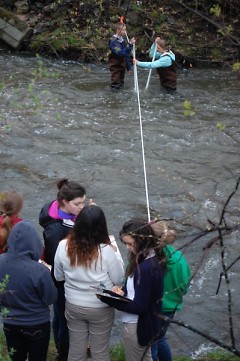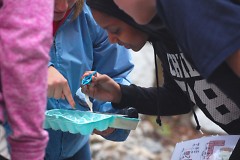What do a bunch of urban teenagers and country kids have in common besides braces, tests and parents telling them to look up from their screens? Well, they also share a common watershed. Over the last two semesters two schools have partnered to explore their relationship to the creek and to each other.
Dutton Christian Middle School science teacher Reuben Sportel and Potter’s House Middle School science teacher EunSub Cho expanded their students’ watershed education this year by partnering with Plaster Creek Stewards to get out and get to know the creek. Last fall the two schools toured the Plaster Creek watershed together-- from Shadyside Park in Dutton where many of the Dutton kids play in and around the creek, to Ken-O-Sha Park, to Roosevelt Park where the Potter’s House kids hang out for recess each day. The students noted the land use changes along the way and were able to see the creek through the eyes of their upstream or downstream neighbors.
Plaster Creek, like many urban creeks, unites a diverse community. It gathers the runoff from farms, large yards and businesses in Dutton, as well as the Caledonia area north to Kentwood. Then it mixes with the waters from the area near Frederik Meijer Gardens, some nice suburbs, and many parking lots on 28th Street that form Little Plaster Creek. In Southeast Grand Rapids it collects the storm water from Calvin College and the malls on 28th Street that run into Whiskey Creek, as well as the waters from the neighborhoods around Indian Trails Golf Course and Ken-O-Sha Park. Finally after gathering the urban street water from the Silver Creek Drain (by Potter’s House Christian School), it streaks down the last straight of way to the Grand River, garnering recognition as the most polluted creek in West Michigan. Residents in these locations comprise a diverse population with one problematic watershed in common.
Following the students’ tour from upstream to downstream, an idea grew. What if the students really looked closely at their section of the creek and measured the health of the stream on the same day and then were able to compare findings with each other? What would the numbers look like? How would their experiences differ or be the same?
Plaster Creek Stewards asked the Calvin College Education department to team up giving their student teachers the opportunity to teach hands-on learning outside the four walls of a classroom. The Calvin Education students learned how to conduct basic research methods, lead a group of 8th graders in the data collection and guide them in analyzing the data. The 8th graders learned how to interpret and reflect on the meaning of the data and present their findings to their peers and/or community. The results were exciting for everyone. Teachers thought it was great to have the 8th graders working with college students, leading to collaborative learning on both ends of the learning spectrum.
The data collection day started cool and wet following a few days of heavy rain, so the creek was “bankfull,” meaning that the water levels were high, fast moving and muddy. The college students led small groups either in Shadyside Park or Roosevelt Park to do one of three research activities. One set of groups donned waders and netted macroinvertebrates. These little “bugs” can reveal a lot about the stream quality at a certain site. The students separated them into species types to identify and count them. The second group measured the stream profile (a cross-section of the stream) requiring them to wade across with a measuring tape and a stadia rod to record depths of the stream bed from one bank to the other. This was especially interesting as the water level at downstream Roosevelt Park was high and excitingly fast. The last group tested the water quality and took samples of the water for e-coli measurements.
After analyzing the data with the Calvin students, the 8th grade “experts” made presentations to share with their peers. They also started making plans for their own restoration projects to address issues in the creek. Potter’s House students each wrote a letter to either a local neighbor of Plaster Creek or a local government official summarizing the project and why the condition of the creek matters. Working with the Calvin students in smaller groups afforded 8th graders greater hands-on learning. Making science come alive with real world problems, deepening the upstream-downstream partnership between the two schools and mentoring by college students were all highlights of the experience.
Learning about the watershed and water quality takes on new meaning when faced with raging torrents of stormwater, netting and sorting insects and collecting water samples. The students wearing waders in the stream found a new connection with classroom facts and principles, while student teachers realized that the classroom comes alive when the walls are redefined by the place we live. This upstream-downstream partnership among the schools begs to be continued with new data samples recorded, not only to understand our watershed but also to unite the students who live here to take action to restore the Plaster Creek watershed.
The Rapidian, a program of the 501(c)3 nonprofit Community Media Center, relies on the community’s support to help cover the cost of training reporters and publishing content.
We need your help.
If each of our readers and content creators who values this community platform help support its creation and maintenance, The Rapidian can continue to educate and facilitate a conversation around issues for years to come.
Please support The Rapidian and make a contribution today.



